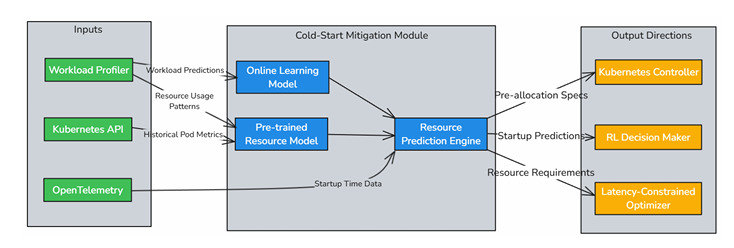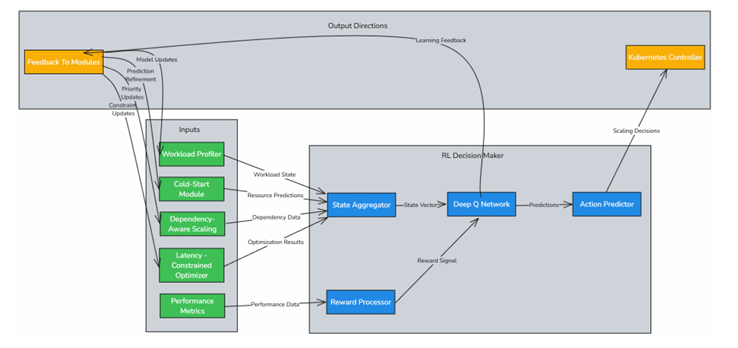AI Dirven Latency Constrained Resource Management In Kubernetes
Team
- E/19/003, Abeysinghe A.M.H.P., e19003@eng.pdn.ac.lk
- E/19/155, Jayarathna B.R.U.K., e19155@eng.pdn.ac.lk
- E/19/166, Jayathunga W.W.K., e19166@eng.pdn.ac.lk
Supervisors
- Prof. Roshan Ragel, roshanr@eng.pdn.ac.lk
- Dr. Isuru Nawinne, isurunawinne@eng.pdn.ac.lk
- Dr. Malith Jayasinghe, malithj@wso2.com
Table of content
- Abstract
- Related works
- Methodology
- Experiment Setup and Implementation
- Results and Analysis
- Conclusion
- Publications
- Links
Abstract
Modern cloud-native applications often run on Kubernetes with conservative resource limits to avoid service degradation. However, this leads to substantial CPU and memory overprovisioning, increasing operational cost without proportional performance benefits. This research addresses the challenge of reducing Kubernetes resource limits and requests for microservices while keeping latency within acceptable Service-Level Objectives (SLOs), specifically allowing no more than a 20% increase from the baseline latency. Through controlled experiments on multiple Java and Go-based microservices, we analyze latency patterns under CPU-only, memory-only, and combined resource reductions. We discover service-specific resource sensitivity profiles, identify non-linear latency cliffs (Critical Reduction Points), and uncover the compounded behavior caused by simultaneous resource constraints. The insights lay the foundation for designing intelligent, SLA-aware resource tuners using machine learning, reinforcement learning, and Bayesian optimization. Our ultimate goal is to integrate this solution into platforms like Choreo to support dynamic, real-time resource tuning that is both cost-effective and performance-stable.
Related works
-
Kubernetes Autoscaling (HPA/VPA/KEDA): Existing autoscaling tools use reactive CPU or memory metrics but lack SLA-awareness or predictive modeling.
-
Reinforcement Learning in Cloud Systems: RL has been applied for VM placement and dynamic autoscaling, but rarely for fine-grained limit tuning in Kubernetes.
-
Bayesian Optimization in Systems Tuning: Used in configuration tuning (e.g., Google Vizier), but underexplored in real-time latency-aware resource policies.
-
CRP Identification: Most prior works do not model Critical Reduction Points (CRPs) or non-linear latency responses.
This work contributes a hybrid of empirical workload characterization and intelligent control for latency-preserving resource tuning.
Methodology
Workload Profiler
The Workload Profiler resides inside each pod and continuously monitors real-time
metrics. These metrics are gathered using Prometheus, Kubernetes API,
OpenTelemetry and serve as the foundation for predicting future resource demands.

Cold-Start Mitigation Module
This module is also deployed within each pod to reduce the delays associated with
starting new pods. By using pre-trained models and incremental online learning
techniques, it predicts the resource requirements of a pod before it starts, enabling proactive resource pre-allocation. This approach ensures that new pods can quickly
become operational without causing service interruptions or performance degradation.
Moreover, by predicting resource needs in advance, the system can reduce the time it
takes to allocate the necessary resources, thus decreasing startup latency and
improving the overall responsiveness of the system.

Dependency-Aware Scaling Module
The Dependency-Aware Scaling Module is deployed at the node level as part of the
Custom Controller. It leverages distributed tracing tools like Jaeger and
OpenTelemetry to map inter-service dependencies and identify critical microservices.
This module ensures that tightly coupled services are allocated prioritized resources, preventing scaling actions from negatively affecting dependent services and
maintaining system balance and efficiency.

Latency Constrained Optimizer
Also part of the Custom Controller, the Latency-Constrained Optimizer utilizes
metaheuristic algorithms, such as Genetic Algorithms (GA) and Simulated Annealing
(SA), to determine the optimal allocation of CPU and memory resources across the
node. The optimizer ensures that scaling decisions do not increase latency by more
than a given threshold. It incorporates a latency prediction model to estimate the impact of resource changes before applying them. By constantly evaluating resource
adjustments and their potential impact on overall system latency, the optimizer strives
to maintain system responsiveness while optimizing resource distribution to prevent
bottlenecks

Reinforcement Learning-Based Decision Maker
This module operates at both the pod level and within the Custom Controller. At the
pod level, a reinforcement learning model using Deep Q Networks learns the optimal
scaling policy based on historical and real-time data. At the node level, the RL model
aggregates feedback from individual pods and collaborates with the
Latency-Constrained Optimizer to refine global scaling decisions. The reward
function penalizes actions leading to excessive latency, ensuring both resource
efficiency and latency awareness in all decisions. Additionally, the RL model
continuously refines its decision-making process, adapting to evolving system
conditions and optimizing scaling policies to meet long-term performance goals.

Experiment Setup and Implementation
Services Tested:
- Prime Verifier (Java)
- Echo (Go)
- Hash Generator (Java)
- Password Generator (Java)
Load Generation:
Constant 10–20 requests/sec per service.
Metrics Collected:
- CPU Usage, CPU Limit, Memory Usage, Memory Limit
- Latency (p95), timestamped at regular intervals
Automation Tools:
- Custom Kubernetes cronjobs for reduction
- Prometheus for monitoring
- Python & Matplotlib for visualization
- Bash/ConfigMaps for limit patching
Results and Analysis
Latency Profiles
CPU-bound Services
- Prime Verifier
- Hash Generator
Memory-resilient Services
- Echo
- Password Generator
Note: Echo remained stable under all reductions.
Critical Reduction Points (CRPs)
Small additional reductions beyond CRP caused exponential latency spikes.
Combined Reductions
Nonlinear and sometimes adaptive behavior observed. For example, the JVM improved under tighter GC pressure.
Comparative Analysis
| Service | CPU-Only | Memory-Only | Combined |
|---|---|---|---|
| Prime Verifier | Gradual spike | Mild | Latency cliff |
| Echo (Go) | No change | No change | Very stable |
| Hash Generator | Immediate spikes | Flat → volatile | Chaotic |
| Password Generator | Step-wise spikes | Bursty | Unexpected dips |
Conclusion
This research reveals that Kubernetes resource tuning is not linear or generic. Different microservices have distinct performance profiles, and static autoscaling is insufficient. We demonstrate that intelligent resource tuning must:
- Respect latency thresholds.
- Detect nonlinear degradation points.
- Adapt dynamically to workload and service architecture.
Our findings will power a machine learning–driven, SLA-aware resource optimizer that can be integrated into Kubernetes platforms like Choreo, enabling developers to reduce cost without compromising performance.
